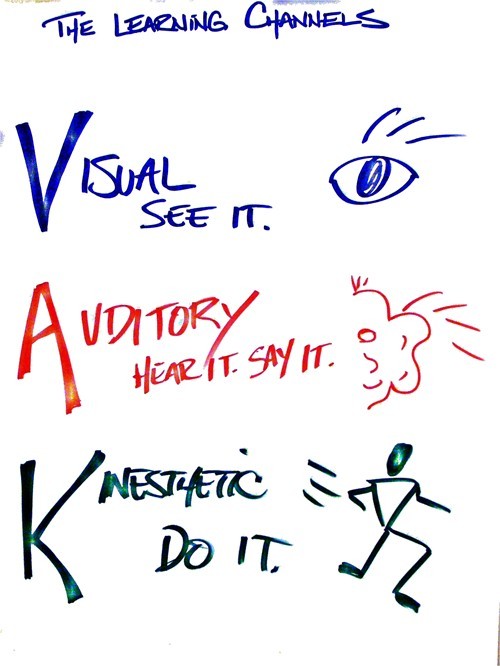Jay Doubleyou: multiple intelligences in the classroom
there are in fact simpler notions of learning styles:
Learning styles - Wikipedia, the free encyclopedia

ITA2 — Visual, Auditory & Kinesthetic Learning Style Model
Here's a helpful overview from BusinessBalls - together with a link to some very good tests:
VAK - visual, auditory, kinesthetic learning styles model
The VAK (or VARK or VACT) learning styles model and related VAK/VARK/VACT tests (and for that matter the Multiple Intelligences concepts) offer reasonably simple and accessible methods to understand and explain people's preferred ways to learn. Occasionally well-intentioned people will write that the use of such models and tests can be problematical. This is true of course of any tool if undue reliance is placed on the methodology, or if the results of tests are treated as absolute and exclusive of other styles and considerations in the overall mix of a person's personality and needs.
As with any methodology or tool, use VAK and other learning styles concepts with care. The concepts are an aid, not a dogma to be followed and applied rigidly. See the notes for using Learning Styles with young people on the Kolb Learning Styles page.
In addition to the VAK guide below, further VAK detail and VAK tests are available on the VAK tests page.
The explanation and understanding of Gardner's Seven Intelligences can be further illuminated and illustrated by looking at another classical intelligence and learning styles model, known as the Visual-Auditory-Kinesthetic (or Kinaesthetic - either is correct) learning styles model or 'inventory', usually abbreviated to VAK. Alternatively the model is referred to as Visual-Auditory-Physical, or Visual-Auditory-Tactile/Kinesthetic.
The VAK concept, theories and methods (initially also referred to as VAKT, for Visual-Auditory-Kinesthetic-Tactile) were first developed by psychologists and teaching specialists such as Fernald, Keller, Orton, Gillingham, Stillman and Montessori, beginning in the 1920's. The VAK multi-sensory approach to learning and teaching was originally concerned with the teaching of dyslexic children and other learners for whom conventional teaching methods were not effective. The early VAK specialists recognised that people learn in different ways: as a very simple example, a child who could not easily learn words and letters by reading (visually) might for instance learn more easily by tracing letter shapes with their finger (kinesthetic). The VAK theory is a favourite of the accelerated learning community, and continues to feature - although not nearly as strongly as it should do - in the teaching and education of young people.
The Visual-Auditory-Kinesthetic learning styles model does not overlay Gardner's multiple intelligences; rather the VAK model provides a different perspective for understanding and explaining a person's preferred or dominant thinking and learning style, and strengths. Gardner's theory is one way of looking at thinking styles; VAK is another.
| learning style | description |
| Visual | seeing and reading |
| Auditory | listening and speaking |
| Kinesthetic | touching and doing |
According to the VAK model, most people possess a dominant or preferred learning style, however some people have a mixed and evenly balanced blend of the three styles.
A person's learning style is a reflection of their mix of intelligences. It is also a reflection of their brain type and dominance, for which a wonderful perspective is provided by Katherine Benziger's brain dominance model.
It is also helpful to look at Kolb's learning styles model.
multiple intelligences - howard gardners multiple intelligences theory - visual auditory kinesthetic learnings styles VAK model
Free VAK visual auditory kinesthetic learning styles test questionnaire
.
.
.
No comments:
Post a Comment